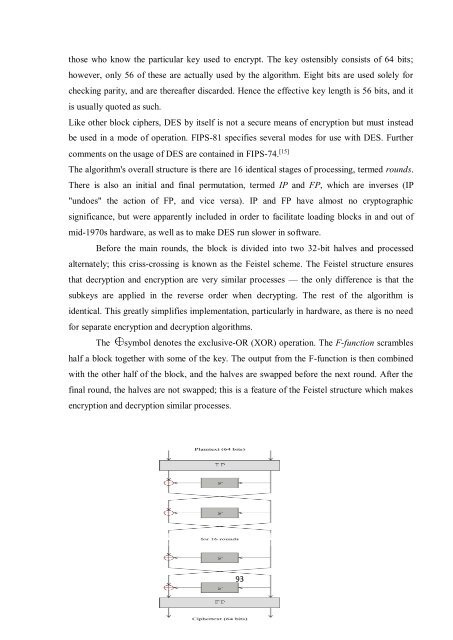combinepdf (5)
You also want an ePaper? Increase the reach of your titles
YUMPU automatically turns print PDFs into web optimized ePapers that Google loves.
those who know the particular key used to encrypt. The key ostensibly consists of 64 bits;<br />
however, only 56 of these are actually used by the algorithm. Eight bits are used solely for<br />
checking parity, and are thereafter discarded. Hence the effective key length is 56 bits, and it<br />
is usually quoted as such.<br />
Like other block ciphers, DES by itself is not a secure means of encryption but must instead<br />
be used in a mode of operation. FIPS-81 specifies several modes for use with DES. Further<br />
comments on the usage of DES are contained in FIPS-74. [15]<br />
The algorithm's overall structure is there are 16 identical stages of processing, termed rounds.<br />
There is also an initial and final permutation, termed IP and FP, which are inverses (IP<br />
"undoes" the action of FP, and vice versa). IP and FP have almost no cryptographic<br />
significance, but were apparently included in order to facilitate loading blocks in and out of<br />
mid-1970s hardware, as well as to make DES run slower in software.<br />
Before the main rounds, the block is divided into two 32-bit halves and processed<br />
alternately; this criss-crossing is known as the Feistel scheme. The Feistel structure ensures<br />
that decryption and encryption are very similar processes — the only difference is that the<br />
subkeys are applied in the reverse order when decrypting. The rest of the algorithm is<br />
identical. This greatly simplifies implementation, particularly in hardware, as there is no need<br />
for separate encryption and decryption algorithms.<br />
The symbol denotes the exclusive-OR (XOR) operation. The F-function scrambles<br />
half a block together with some of the key. The output from the F-function is then combined<br />
with the other half of the block, and the halves are swapped before the next round. After the<br />
final round, the halves are not swapped; this is a feature of the Feistel structure which makes<br />
encryption and decryption similar processes.<br />
93




